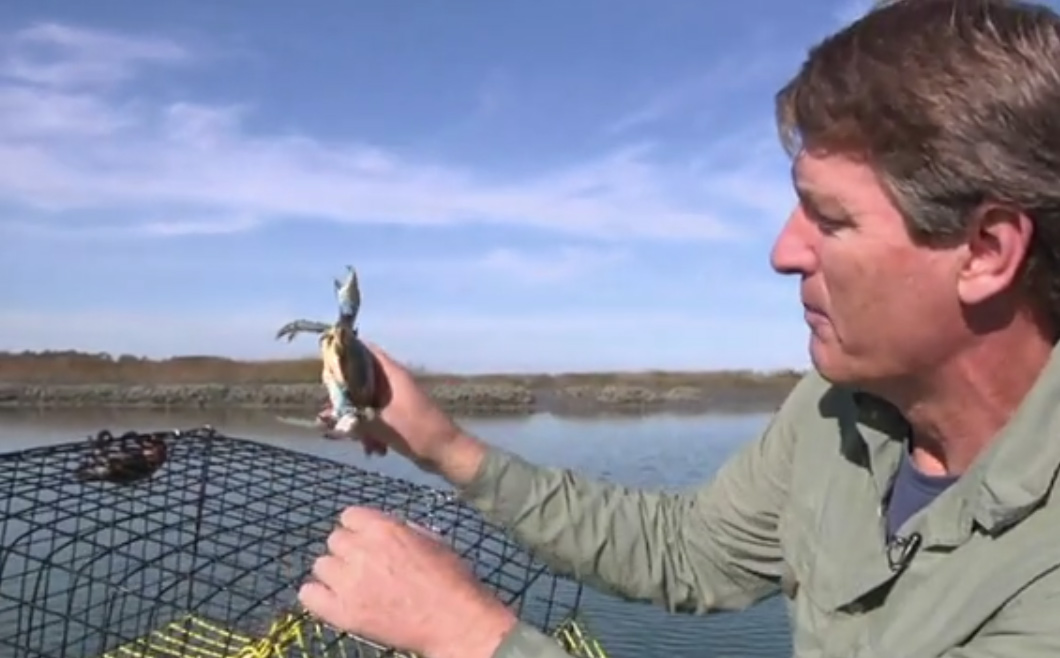Blue Crabs
I sure remember the first time I got really "tagged" by a blue crab.
I was conducting field work in coastal South Carolina, netting diamondback terrapins for a population study with a group of graduate students. We positioned two jon boats along the edge of a trammel net so everyone could see any turtles caught in the mesh. As I reeled the 50 foot net into the jon boat, I rested a swath of bundled net across my legs so I could collect another section into my hands. Feeling a jolt of searing pain, I looked down to see a blue crab pinching the inner portion of my thigh with one of his claws. I squirmed around on the boat seat and wiggled my body in an awkward attempt to remove the net and (more importantly) the crab from my lap. This seemed to irritate the feisty crustacean, causing him to sink the other claw into my leg. I stood up on the boat bench and shook my legs and hips violently performing an impromptu "crab dance" until the little guy fell off. Although I escaped the ordeal with very little physical damage and provided unplanned entertainment for the students, this event probably left some significant scars on my psyche.

The scientific name of the blue crab (Callinectes sapidus) loosely translates into "beautiful savory swimmer". Adult blue crabs are adorned with a pleasing complement of blue and red hues on a light gray background. They are excellent examples of form following function because every body part is designed for mate acquisition, feeding or protection. The first pair of legs (claws) is important for feeding, fighting and holding a female during mating. These appendages possess great power allowing a crab to crush small mollusks and to rip apart fish and other marine animals into bite-sized pieces. The middle legs are for traditional walking but the last pair of legs are flattened paddles giving the crab great swimming ability.
Crabs are formidable predators feeding on just about any type of marine life small enough to capture and overpower. They often rest beneath the sand or "pluff" mud with just their eye-stalks exposed. Since they have excellent vision, they wait for an unwary victim to venture too close and blast out from under cover and grab it. Blue crabs are cannibals feeding on their own kind especially "softshell" crabs that have recently molted. They may also venture up into the high salt marsh and pluck periwinkles and other snails off the spartina grass for eating.
Blue crabs are extremely important to the economy of the lowcountry. They are harvested in local waters and shipped all over the world as food. Many of our crabs are shipped up the coast and marketed as Maryland blue crabs. During certain periods of the year when the crabs are about to molt they are collected for the seafood industry. Experienced crabbers are very adept at identifying animals that are about to shed their exoskeletons. Crabs in this condition ("peelers") are placed in tanks until they molt and marketed as "softshells".
Blue crabs mate throughout the warmer months of the year with peaks in the Spring and Fall in lower salinity waters. Although males likely mate many times, females mate only after their final molt and must be in a softshell condition. The adult females called ‘sooks" give off chemical signals (pheromones) to announce their reproductive condition. The larger males or "Jimmies" will stay with the female until she molts and mating is accomplished. He will continue to "cradle" her to keep other males away and let her shell harden before releasing her.
Two to nine months later, females will develop a mass of about two million eggs under the apron of the shell. This "sponge" of eggs bulges out on all sides and remains attached to her abdomen until the eggs are ready to hatch. After hatching, the larvae are "wisked" away by the tides to fend for themselves. If they are not eaten by a variety of marine predators, they will molt frequently and go through a series of larval stages reaching maturity a year and a half later. At this point these guys can mate themselves and produce the next generation of tasty crustaceans.
Tags: marine life